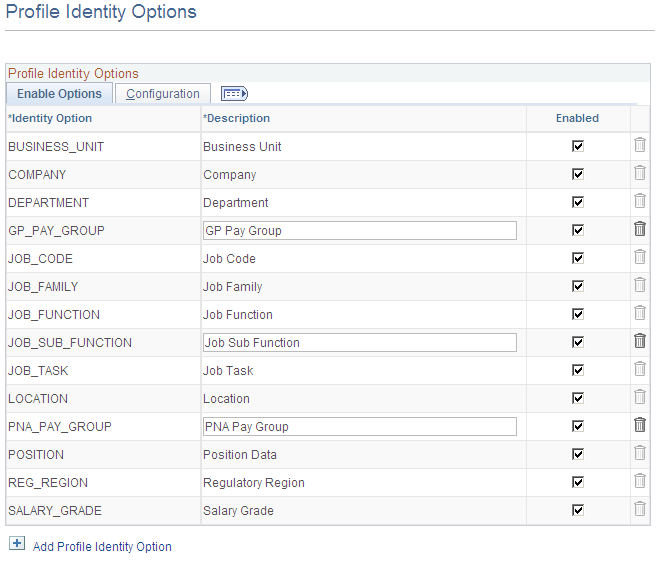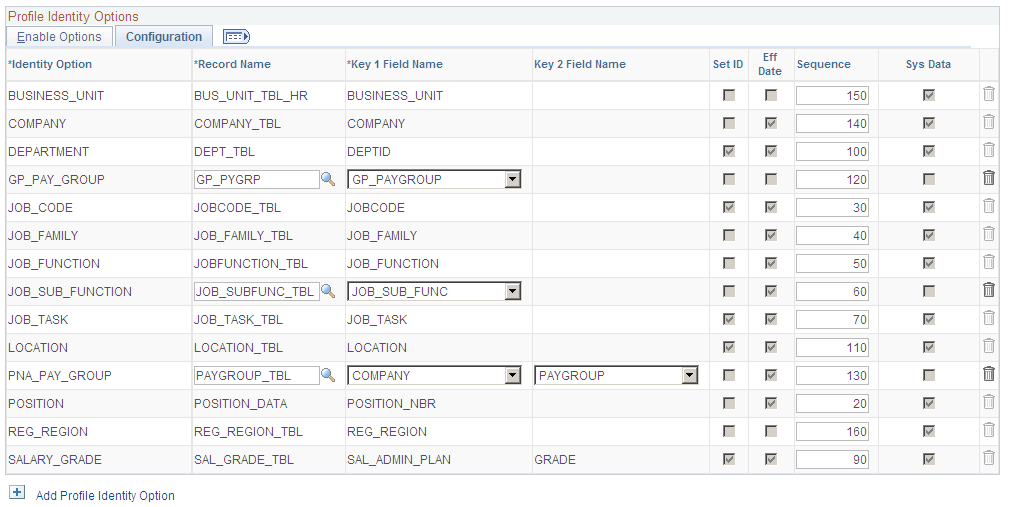Setting Up Profile Identity and Association Options
To set up profile identity options and profile association options for your organization, use the Profile Identity Options (JPM_RLAT_SETUP) and the Profile Association Options (JPM_RLAT_ASC_SETUP) components.
These topics discuss how to set up profile identity and association options.
|
Page Name |
Definition Name |
Usage |
|---|---|---|
|
JPM_RLAT_SETUP |
Define profile identity options, which can be linked to profile types. Entities include job codes, job functions, job families, people, and salary grades. The entities enabled on this page determine which options are available on the Identities page of the Profile Type component that defines the structure of a non-person profile. For example, if you enable Job Codes you can set up a profile type that is linked to job code. A set of default profile identity options is delivered but you can add to the list according to your requirements. |
|
|
JPM_RLAT_SETUP |
Define the entities external to the Manage Profiles business process to which you can link profile types. One association option is delivered that enables you to link a profile type to ePerformance templates. The addition of other associations would require customizations to leverage it. |
Field or Control |
Description |
|---|---|
Identity Option |
Enter the name of the entity to which you can link a profile. For the delivered identity and association options, this field is display-only. Identity options are entities within the Profile Management business process, such as job code or position, whereas association options are entities external to the Profile Management business process. One association option is delivered that enables you to associate a profile type to an ePerformance template to automatically resolves which template is selected during document creation process. |
Enabled |
Select this check box to allow profile types to be linked to the entity specified in the Identity Option field. |
Record Name |
Select the record that defines the entity specified in the Identity Option field. This field is display-only for identity options that are delivered as system data (Sys Data check box is selected). |
Key 1 Field Name |
Displays the key field for the record selected in the Record Name field. |
Key 2 Field Name, Key 3 Field Name, Key 4 Field Name |
Displays the additional key fields for the record. These fields are hidden if the record has one key field only. |
SetID |
Indicates if SetID is a key field for the selected record. The system automatically selects this check box based on the record definition and makes the field display-only. |
Eff Date (effective date) |
Indicates if the effective date field is a key field for the selected record. The system automatically selects this check box based on the record definition and makes the field display-only. |
Use the Profile Identity Options page (JPM_RLAT_SETUP) to define profile identity options, which can be linked to profile types.
Entities include job codes, job functions, job families, people, and salary grades. The entities enabled on this page determine which options are available on the Identities page of the Profile Type component that defines the structure of a non-person profile. For example, if you enable Job Codes you can set up a profile type that is linked to job code.
A set of default profile identity options is delivered but you can add to the list according to your requirements.
Only those records that are used for prompting on JOB and JOB_JR non-key record fields can be selected. Person profile identifiers cannot be defined.
Navigation:
This example illustrates the fields and controls on the Profile Identity Options page: Enable Options tab. You can find definitions for the fields and controls later on this page.

Field or Control |
Description |
|---|---|
Add Profile Identity Option |
Click this link to add a new profile identity option. |
Enable Options Tab
Field or Control |
Description |
|---|---|
Enabled |
Select this check box to allow profile types to be linked to the entity specified in the Identity Option field. If this check box is deselected, you cannot set up a profile type with this entity. For example, if you deselect the check box for the Job_Sub_Function option, you cannot define a profile type using the Job_Sub_Function profile identity option. |
Configuration Tab
Access the Configuration tab on the Profile Identity Options page.
This example illustrates the fields and controls on the Profile Identity Options page: Configuration tab. You can find definitions for the fields and controls later on this page.

Field or Control |
Description |
|---|---|
Sequence |
Enter the number that determines the order in which non-person profiles related to a person's job are listed. The system uses the sequence value as follows:
|
See Common Elements Used to Define Profile Identity and Association Options.
Use the Profile Association Options page (JPM_RLAT_SETUP) to define the entities external to the Manage Profiles business process to which you can link profile types.
One association option is delivered that enables you to link a profile type to ePerformance templates. The addition of other associations would require customizations to leverage it.
Navigation:
This example illustrates the fields and controls on the Profile Association Options page: Enable Options tab. You can find definitions for the fields and controls later on this page.

This example illustrates the fields and controls on the Profile Association Options page: Configuration tab. You can find definitions for the fields and controls later on this page.

Use this page to define the entities external to the Manage Profiles business process to which you can link profile types. ePerformance Template is a delivered profile association option. The addition of other associations would require customizations to leverage. Enter the identity option on the Enable Options tab. Enter the record name and key field information on the Configuration tab.
Field or Control |
Description |
|---|---|
Add Profile Association Option |
Click this link to add a new profile association option. |
See Common Elements Used to Define Profile Identity and Association Options.